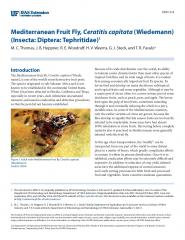White Sapote or Casimiroa edulis is a fruit tree of about 18 m tall that can be found in Central America. It has drooping and spreading branches, its leaves are compound palmate and arranged alternately, and its fruits are ovoid drupes. The fruit is consumed either raw or cooked but its seeds are reportedly toxic if eaten raw. Medicinally, white sapote?s different plant parts are used as sedative or as treatment for diabetes, arthritis, rheumatism, and putrid sores.
Casimiroa edulis is an evergreen Tree growing to 16 m by 16 m at a medium rate.
It is hardy to zone 9. The flowers are pollinated by Bees.
It is noted for attracting wildlife.
Suitable for: light , medium and heavy soils and prefers well-drained soil. Suitable pH: acid, neutral and basic soils and can grow in very alkaline and saline soils.
It cannot grow in the shade. It prefers moist soil and can tolerate drought.
Plants are about as hardy as a lemon , which means that they can tolerate occasional frosts. In tropical latitudes the plant can be found at elevations between 700 - 3,000 metres, but it is best grown between 1,000 - 2,000 metres. In subtropical climate it can be grown at sea level. It is distinctly subtropical in its climatic requirements, surviving light frosts. On the other hand, flowering during the coldest months tends to result in poor fruit set. Plants are unlikely to do well in lowland tropical areas, especially in the wetter regions. Temperature range for growth is reported to be 14 - 31c with the optimum between 18 - 26c. Temperatures around -1 to -2c may injure young growing shoots and cause fruit drop, whereas temperatures about -3 to -4?c may kill the tree to the ground. Annual rainfall range for growth is reported to be 500 - 4,000mm with the optimum between 1,500 - 3,000mm. Prefers an open, well-drained site on a loamy soil. Prefers a pH in the range 7 - 7.5, tolerating 6.5 - 8. Established plants are drought resistant, though they need adequate moisture if they are to fruit well. Seedling trees usually begin to bear in 7 - 8 years. Grafted trees start bearing in 3 - 4 years. Trees can flower and produce fruit at more than one time of the year. A mature tree can produce more than 100 kilos of fruit a year. There are many named varieties. Frequent light pruning is possible to increase the number of fruiting arms but pruning should not be too heavy. Fruit are picked when colour changes occur and ripened off the tree. They can be stored at 5C for 3-6 weeks. Adding potash prior to fruiting and nitrogen prior to vegetative regrowth is suggested for increased yield. Fruit yields are high. Fruit are easily damaged.
HabitatsSubtropical deciduous woodlands and low forests. Dryish highland forests at elevations of 600 - 1Habitats000 metres.
Resources
IN37100

EENY-214
Mediterranean Fruit Fly, Ceratitis capitata (Wiedemann)
(Insecta: Diptera: Tephritidae) 1https://edis.ifas.ufl.edu/pdffiles/IN/IN37100.pdfIN37100IN37100
EENY-214
EDIS - Electronic Data Information Source - UF/IFAS Extension
Mediterranean Fruit Fly, Ceratitis capitata (Wiedemann)
(Insecta: Diptera: Tephritidae) 1
